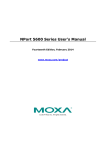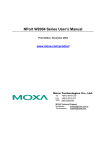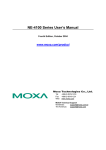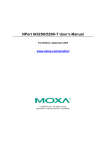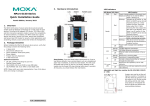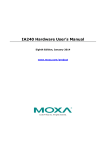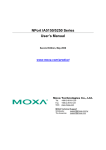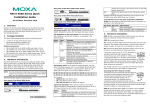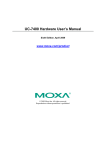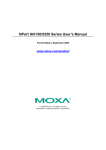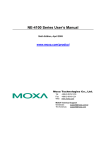Download 5610-16/5610-8 User`s Manual
Transcript
5610-16/5610-8 User’s Manual First Edition, August 2003 Moxa Technologies Co., Ltd. Tel: +886-2-8919-1230 Fax: +886-2-8919-1231 www.moxa.com [email protected] 5610-16/5610-8 User’s Manual The software described in this manual is furnished under a license agreement and may be used only in accordance with the terms of that agreement. Copyright Notice Copyright 2003 Moxa Technologies Co., Ltd. All rights reserved. Reproduction without permission is prohibited. Trademarks MOXA is a registered trademark of Moxa Technologies Co., Ltd. All other trademarks or registered marks in this manual belong to their respective manufacturers. Disclaimer Information in this document is subject to change without notice and does not represent a commitment on the part of Moxa. Moxa provides this document “as is,” without warranty of any kind, either expressed or implied, including, but not limited to, its particular purpose. Moxa reserves the right to make improvements and/or changes to this manual, or to the products and/or the programs described in this manual, at any time. Information provided in this manual is intended to be accurate and reliable. However, Moxa Technologies assumes no responsibility for its use, or for any infringements on the rights of third parties that may result from its use. This product might include unintentional technical or typographical errors. Changes are periodically made to the information herein to correct such errors, and these changes are incorporated into new editions of the publication. Table of Contents Chapter 1 Introduction........................................................................................1-1 Chapter 2 Getting Started...................................................................................2-1 Chapter 3 Initial IP Address Configuration ......................................................3-1 Chapter 4 Choosing the Proper Operation Mode ............................................4-1 Chapter 5 Web Console Configuration.............................................................5-1 Chapter 6 Configuring Windows Administrator ..............................................6-1 Overview ................................................................................................ 1-2 Package Checklist.................................................................................. 1-2 Product Features.................................................................................... 1-2 Product Specifications............................................................................ 1-3 Panel Layout .......................................................................................... 2-2 Connecting the Hardware ...................................................................... 2-3 Wiring Requirements ................................................................................ 2-3 Connecting NPort 5610-8/16’s Power ...................................................... 2-3 Connecting NPort 5610-8/16-48V’s Power .............................................. 2-4 Grounding NPort 5610-16-48V/5610-8-48V............................................ 2-4 Connecting to the Network ....................................................................... 2-4 Connecting to a Serial Device................................................................... 2-5 LED Indicators.......................................................................................... 2-5 Initializing NPort’s IP Address ................................................................ 3-2 Factory Default IP Address .................................................................... 3-2 LCM Display ........................................................................................... 3-2 NPort Administration Suite ..................................................................... 3-5 ARP ........................................................................................................ 3-5 Telnet Console ....................................................................................... 3-6 Overview ................................................................................................ 4-2 TCP Server Mode .................................................................................. 4-2 TCP Client Mode .................................................................................... 4-3 UDP Mode.............................................................................................. 4-3 Real COM Mode..................................................................................... 4-3 Opening Your Browser........................................................................... 5-2 Basic Settings......................................................................................... 5-4 Network Settings .................................................................................... 5-6 Serial Settings ........................................................................................ 5-9 Operating Settings ............................................................................... 5-11 Real COM Mode..................................................................................... 5-11 TCP Server Mode ................................................................................... 5-13 TCP Client Mode .................................................................................... 5-17 UDP Mode .............................................................................................. 5-20 Accessible IP Settings.......................................................................... 5-22 Auto Warning Settings ......................................................................... 5-23 Auto warning: E-mail and SNMP Trap .................................................. 5-23 Event Type.............................................................................................. 5-24 Change Password ................................................................................ 5-26 Load Factory Default............................................................................ 5-27 Overview ................................................................................................ 6-2 Installing Windows Administrator ........................................................... 6-2 Configuration .......................................................................................... 6-4 Broadcast Search....................................................................................... 6-5 Unlock Password Protection ..................................................................... 6-6 Configuring NPort 5610-16/5610-8.......................................................... 6-7 Upgrading Firmware................................................................................. 6-8 Export/Import............................................................................................ 6-9 Monitor ................................................................................................. 6-10 Port Monitor.......................................................................................... 6-13 COM Mapping ...................................................................................... 6-14 On-line COM Mapping........................................................................... 6-14 Off-line COM Mapping .......................................................................... 6-17 IP Location ........................................................................................... 6-18 Chapter 7 IP Serial LIB........................................................................................7-1 Appendix A Pinouts and Cable Wiring................................................................ A-1 Appendix B Well Known Port Numbers .............................................................. B-1 Appendix C SNMP Agent with MIB II & RS-232 Like Group ............................. C-1 Appendix D Service Information.......................................................................... D-1 Overview ................................................................................................ 7-2 IP Serial LIB Function Groups................................................................ 7-3 Example Program .................................................................................. 7-3 Port Pinout Diagrams .............................................................................A-2 Ethernet Port Pinouts ............................................................................... A-2 Serial Port Pinouts ................................................................................... A-2 Cable Wiring Diagrams ..........................................................................A-3 Ethernet Cables ........................................................................................ A-3 Serial Cables ............................................................................................ A-3 Pin Assignments of DB9 and DB25 Connectors ..................................... A-5 MOXA Internet Services.........................................................................D-2 Problem Report Form.............................................................................D-3 Product Return Procedure .....................................................................D-4 1 Chapter 1 Introduction Welcome to MOXA NPort 5600 Series of advanced serial device servers that make it easy to network and to enable your serial devices. NPort 5610-16/5610-8 comes with 16/8 RS-232 ports. The following topics are covered in this chapter: Overview Package Checklist Product Features Product Specifications Overview NPort 5600 Series serial device servers are designed to make your industrial serial devices Internet ready instantly. The compact size of NPort 5600 device servers makes them the ideal choice for connecting your RS-232 serial devices—such as PLCs, meters, and sensors—to an IP-based Ethernet LAN, making it possible for your software to access serial devices anywhere over a local LAN or the Internet. NPort 5600 serial device servers ensure the compatibility of network software that uses a standard network API (Winsock or BSD Sockets) by providing TCP Server Mode, TCP Client Mode, and UDP Mode. And thanks to NPort’s Real COM/TTY drivers, software that works with COM/TTY ports can be set up to work over a TCP/IP network in no time. This excellent feature preserves your software investment and lets you enjoy the benefits of networking your serial devices instantly. NPort 5600 serial device servers support automatic IP configuration protocols (DHCP, BOOTP) and manual configuration via NPort’s handy web browser console. Both methods ensure quick and effective installation. And with NPort 5600’s Windows Utility, installation is very straightforward, since all system parameters can be stored and then copied to other device servers simultaneously. Package Checklist MOXA NPort 5610-16/5610-8 products are shipped with the following items: Standard Accessories y y y y 1 16- or 8-port serial device server NPort Document & Software CD NPort 5600 Quick Installation Guide Power cord Optional Accessories y y y y CBL-RJ45M9-150 CBL-RJ45F9-150 CBL-RJ45M25-150 CBL-RJ45F25-150 RJ45 8-pin to DB9 Male cable, 150 cm RJ45 8-pin to DB9 Female cable, 150 cm RJ45 8-pin to DB25 Male cable, 150 cm RJ45 8-pin to DB25 Female cable, 150 cm NOTE: Notify your sales representative if any of the above items is missing or damaged. Product Features NPort 5600 Series products enjoy the following features: y y y y y y y y 1-2 Make your serial devices Internet ready Easy-to-use LCM (Liquid Crystal Module) interface for setting up IP address Versatile socket operation modes, including TCP Server, TCP Client, and UDP Easy-to-use Windows Utility for mass installation Supports 10/100 Mbps Ethernet—auto detectable Supports 16/8-port RS-232 interface Built-in 15 KV ESD protection for all serial signals Supports SNMP MIB-II for network management NPort 5610-16/5610-8 User’s Manual Introduction Product Specifications LAN Ethernet Protection 10/100 Mbps, RJ45 Built-in 1.5 KV magnetic isolation Serial Interface No. of Ports Port Type Signals Serial Line Protection RS-232 16/8 RJ45 8-pin TxD, RxD, RTS, CTS, DTR, DSR, DCD, GND 15 KV ESD for all signals Power Line Protection 4 KV Burst (EFT), EN61000-4-4 2 KV Surge, EN61000-4-5 Advanced Built-in Features HMI LCM display with four push buttons Buzzer Real-Time Clock Watch Dog Timer Serial Communication Parameters Parity None, Even, Odd, Space, Mark Data Bits 5, 6, 7, 8 Stop Bit 1, 1.5, 2 Flow Control RTS/CTS, XON/XOFF Transmission Speed 50 bps to 230.4 Kbps Software Features Protocols Utilities Real COM/TTY Drivers Configuration Power Requirements Power Input Power Consumption Mechanical Material Dimensions (W × H × D) ICMP, IP, TCP, UDP, DHCP, BOOTP, Telnet, DNS, SNMP, HTTP, SMTP, SNTP NPort Administrator for Windows 95/98/ME/NT/2000/XP Windows 95/98/ME/NT/2000/XP Real COM driver, Linux real TTY driver Web Browser, Telnet Console, or Windows Utility 100 to 240 VAC, 47 to 63 Hz, or 48 VDC NPort 5610-8/16: 200 mA for 100V, 130 mA for 240V NPort 5610-8/16-48V: 190 mA (at 48V max.) SECC sheet metal (1 mm) 190 × 44.5 × 478 mm (including ears) 190 × 44.5 × 440 mm (without ears) NPort 5610-16/5610-8 User’s Manual 1-3 1-4 Environment Operating Temperature Storage Temperature 0 to 55°C (32 to 131°F), 5 to 95%RH -20 to 85°C (-4 to 185°F), 5 to 95%RH Regulatory Approvals EMC Safety WARRANTY FCC Class A, CE Class A UL, CUL, TÜV 5 years NPort 5610-16/5610-8 User’s Manual 2 Chapter 2 Getting Started This chapter includes information about installing NPort 5610-16/5610-8. The following topics are covered: Panel Layout Connecting the Hardware ¾ Wiring Requirements ¾ Connecting the Power ¾ Grounding NPort 5610-16-48V/5610-8-48V ¾ Connecting to the Network ¾ Connecting to a Serial Device ¾ LED Indicators Panel Layout Front panel of NPort 5610-16-48V Rear panel of NPort 5610-16 (AC Power) Rear panel of NPort 5610-16 -48V (DC Power) Reset Button—Press the Reset button continuously for 5 sec to load factory defaults: Use a pointed object, such as a straightened paper clip or toothpick, to press the reset button. This will cause the Ready LED to blink on and off. The factory defaults will be loaded once the Ready LED stops blinking (after about 5 seconds). At this point, you should release the reset button. 2-2 NPort 5610-16/5610-8 User’s Manual Getting Started Connecting the Hardware This section describes how to connect NPort 5610-16/5610-8 to serial devices for first time testing purposes. We cover Wiring Requirements, Connecting the Power, Grounding NPort 5610-16-48V/5610-8-48V, Connecting to the Network, Connecting to a Serial Device, and LED Indicators. Wiring Requirements Safety First! Be sure to disconnect the power cord before installing and/or wiring your NPort 5610-16/5610-8. Wiring Caution! Calculate the maximum possible current in each power wire and common wire. Observe all electrical codes dictating the maximum current allowable for each wire size. If the current goes above the maximum ratings, the wiring could overheat, causing serious damage to your equipment. Temperature Caution! Please take care when handling NPort 5610-16/5610-8. When plugged in, NPort 5610-16/5610-8’s internal components generate heat, and consequently the casing may feel hot to the touch. You should also pay attention to the following points: z Use separate paths to route wiring for power and devices. If power wiring and device wiring paths must cross, make sure the wires are perpendicular at the intersection point. NOTE: Do not run signal or communication wiring and power wiring in the same wire conduit. To avoid interference, wires with different signal characteristics should be routed separately. z You can use the type of signal transmitted through a wire to determine which wires should be kept separate. The rule of thumb is that wiring that shares similar electrical characteristics can be bundled together. z Keep input wiring and output wiring separate. z Where necessary, it is strongly advised that you label wiring to all devices in the system. Connecting NPort 5610-8/16’s Power Connect NPort 5610-8/16’s 100-240 VAC power line with its AC connector. If the power is properly supplied, the “Ready” LED will show a solid red color until the system is ready, at which time the “Ready” LED will change to a green color. NPort 5610-16/5610-8 User’s Manual 2-3 Connecting NPort 5610-8/16-48V’s Power To connect NPort 5610-8-16/48V’s power cord with its terminal block, follow the steps given below: 1. Loosen the screws on the V+ and V- terminals of NPort 5610-8/16-48V’s terminal block. 2. Connect the power cord’s 48 VDC wire to the terminal block’s V+ terminal, and the power cord’s DC Power Ground wire to the terminal block’s V- terminal, and then tighten the terminal block screws. (Note: NPort 5610-8/16-48V can still operate even if the DC 48V and DC Power Ground are reversed.) If the power is properly supplied, the “Ready” LED will show a solid red color until the system is ready, at which time the “Ready” LED will change to a green color. NOTE You need 8kg-cm of Screw Torque Value and 22-14 AWG of Suitable Electric Wire to connect NPort 5610-8/16-48V’s power cord to its terminal block. Grounding NPort 5610-16-48V/5610-8-48V Grounding and wire routing helps limit the effects of noise due to electromagnetic interference (EMI). Run the ground connection from the ground screw to the grounding surface prior to connecting devices. The Shielded Ground (sometimes called Protected Ground) contact is the second contact from the right of the 5-pin power terminal block connector located on the rear panel of NPort 5610-16-48V/5610-8-48V. Connect the SG wire to the Earth ground. This product is intended to be mounted to a well-grounded mounting surface such as a metal panel. Connecting to the Network Connect one end of the Ethernet cable to NPort 5610-16/5610-8’s 10/100M Ethernet port and the other end of the cable to the Ethernet network. There are 2 LED indicators located on the bottom left and right corners of the Ethernet connector. If the cable is properly connected, NPort 5610-16/5610-8 will indicate a valid connection to the Ethernet in the following ways: The bottom right corner LED indicator maintains a solid green color when the cable is properly connected to a 100 Mbps Ethernet network. The bottom left corner LED indicator maintains a solid orange color when the cable is properly connected to a 10 Mbps Ethernet network. 2-4 NPort 5610-16/5610-8 User’s Manual Getting Started Connecting to a Serial Device Connect the serial data cable between NPort 5610-16/5610-8 and the serial device. LED Indicators The front panels of NPort 5610-16/5610-8 have several LED indicators, as described in the following table. LED Name LED Color off red Ready LED Function Power is off, or power error condition exists. Steady on: Power is on and NPort is booting up. Blinking: Indicates an IP conflict, or DHCP or BOOTP server did not respond properly. Steady on: Power is on and NPort is functioning normally. green 1-16 orange green off Blinking: The NPort has been located by NPort Administrator’s Location function. Serial port is receiving data. Serial port is transmitting data. No data is being transmitted or received through the serial port. NPort 5610-16/5610-8 User’s Manual 2-5 3 Chapter 3 Initial IP Address Configuration When setting up your NPort 5610-16/5610-8 for the first time, the first thing you should do is configure the IP address. This chapter introduces several methods to configure NPort’s IP address. You can choose whichever method that is the most convenient for you. For more details about network settings, see the Network Settings section from Chapter 5, Web Console Configuration. This chapter includes the following sections: Initializing NPort’s IP Address Factory Default IP Address LCM Display Å recommended configuration method NPort Administration Suite Å recommended configuration method ARP Telnet Console Initializing NPort’s IP Address 1. Determine whether your NPort needs to use a Static IP or Dynamic IP (either DHCP or BOOTP application). 2. If NPort is used in a Static IP environment, you can use NPort Administration Suite, ARP, Web Console, or Telnet Console to configure the new IP address. 3. If NPort is used in a Dynamic IP environment, you can use NPort Administration suite, Web Console, or Telnet Console to configure NPort to get an IP address dynamically with DHCP, DHCP/BOOTP, or BOOTP. Consult your network administrator on how to reserve a fixed IP address (for your NPort) in the MAC-IP mapping table when using a DHCP Server or BOOTP Server. In most applications, you should assign a fixed IP address to your NPort. Factory Default IP Address NPort products are configured with the following default private IP address: Default IP address: 192.168.127.254 (IP addresses of the form 192.168.xxx.xxx are referred to as private IP addresses, since it is not possible to directly access a device configured with a private IP address from a public network. For example, you would not be able to ping such a device from an outside Internet connection. NPort applications that require sending data over a public network, such as the Internet, require setting up the server with a valid public IP address, which can be leased from a local ISP.) LCM Display We recommend using LCM display and four push buttons to configure the IP address at the first time installation. Basic Operation If the NPort is working properly, the LCM panel will display a green color. The red Ready LED will also light up, indicating that the NPort is receiving power. After the red Ready LED turns to green, you will see a display similar to: N P 5 6 1 0 - 1 6 _ 3 8 1 9 2 . 1 6 8 . 1 2 7 . This is where • NP5610-16 • 38 • 192.168.127.254 3-2 is the NPort’s name is the NPort’s serial number is the NPort’s IP address NPort 5610-16/5610-8 User’s Manual 2 5 4 Initial IP Address Configuration There are four push buttons on NPort’s nameplate. Going from left to right, the buttons are: Button MENU Name menu Action activates the main menu, or returns to an upper level U up cursor V down cursor SEL select scrolls up through a list of items shown on the LCM panel’s second line scrolls down through a list of items shown on the LCM panel’s second line selects the option listed on the LCM panel’s second line The buttons are manipulated in a manner similar to the way a modern cellular phone operates. As you move through the various functions and setting options, note that the top line shows the current menu or submenu name, and the bottom line shows the submenu name or menu item which is activated by pressing the SEL button. Detailed Menu Options The best way to explain all of NPort’s LCM functions is to refer to the tree graph shown in the next page. There are three main levels—1, 2, and 3—with each level represented by a separate column. The first thing to remember is that the MENU button is used to move back and forth between the LCM panel’s default screen, and main menu screen: N P 5 6 1 0 - 1 6 _ 3 8 1 9 2 . 1 6 8 . 1 2 7 . 2 5 M S a e i r n v M r e e n s U e t t i n g 4 ↓ In addition, you only need to remember to: • Use the SEL button to move up one level (i.e., left to right on the tree graph) • Use the MENU button to move down one level (i.e., right to left on the tree graph) • Use the cursor keys, U and V, to scroll between the various options within a level (i.e., up and down on the tree graph). NPort 5610-16/5610-8 User’s Manual 3-3 As you use the buttons to operate the LCM display, you will notice that with very few exceptions, moving up one level causes the bottom line of the display to move to the top line of the display. You will also notice that the bottom three options in level 2, and all of the options in level 3 have either a C or D attached. The meaning is as follows: • C = configurable I.e., you are allowed to change the setting of this option • D = display only I.e., the setting for this option is displayed, but it cannot be changed (this does NOT necessarily mean that the number doesn’t change; only that you can’t change it) Main Menu Server setting Serial number Server name Firmware ver Model name Network Ethernet status setting MAC address IP config IP address Netmask Gateway DNS server 1 DNS server 2 Serial set Select port Baud rate Data bit Stop bit Parity Flow control Tx/Rx fifo Interface Tx/Rx bytes Line status Op Mode set Select port Select mode [mode] Real COM Alive timeout Max connection Delimiter 1 Delimiter 2 Force Tx Console D C D D D D C C C C C C C C C C C C C C D D C C TCP server Alive timeout Inact. time Max connection Delimiter 1 Delimiter 2 Force Tx Local TCP port Command port Web console Telnet console Ping Save/Restart 3-4 NPort 5610-16/5610-8 User’s Manual TCP client Alive timeout Inact. time Delimiter 1 Delimiter 2 Force Tx Dest IP-1 TCP port-1 Dest IP-2 TCP port-2 Dest IP-3 TCP port-3 Dest IP-4 TCP port-4 TCP connect UDP svr/cli Delimiter 1 Delimiter 2 Force Tx Dest IP start-1 Dest IP end-1 Dest port-1 Dest IP start-2 Dest IP end-2 Dest port-2 Dest IP start-3 Dest IP end-3 Dest port-3 Dest IP start-4 Dest IP end-4 Dest port-4 Local port C C C C C C C C C C C C C C C C C C C C Initial IP Address Configuration The part of the LCM operation that still requires some explanation is how to edit the configurable options. In fact, you will only encounter two types of configurable options. The first type involves entering numbers, such as IP addresses, Netmasks, etc. In this case, you change the number one digit at a time. The up cursor (U) is used to decrease the highlighted digit, the down cursor (V) is used to increase the highlighted digit, and the sel button is used to move to the next digit. When the last digit has been changed, pressing sel simply enters the number into NPort 5610 Series’ memory. The second type of configurable option is when there are only a small number of options from which to choose (although only one option will be visible at a time). Consider the Parity attribute under Serial set as an example. Follow the tree graph to arrive at the following Parity screen. The first option, None, is displayed, with a down arrow all the way to the right. This is an indication that there are other options from which to choose. P N a O r n i e t Y ↓ Press the down cursor button once to see Odd as the second option. P a r O d d i t ↑ ↓ Y Press the down cursor button again to see Even as the third option. P A R I E v e n T ↑ ↓ Y Press the down cursor button again to see Space as the fourth option. P A R I T S p a c e ↑ Y ↓ Press the down cursor button yet again to see the last option, Mark. P M A a R r I k T ↑ Y To choose the desired option, press the SEL button when the option is showing on the screen. NPort Administration Suite NPort Administration Suite consists of some useful utility programs that are used to configure and manage your NPorts. See Chapter 5 for details on how to install NPort Administration Suite, and how to use this suite of useful utilities to set up IP addresses and configure your NPort. ARP You can make use of the ARP (Address Resolution Protocol) command to set up an IP address for your NPort. The ARP command tells your computer to associate the NPort’s MAC address with the intended IP address. You must then use Telnet to access the NPort, at which point the Device Server’s IP address will be reconfigured. NPort 5610-16/5610-8 User’s Manual 3-5 In order to use this setup method, both your computer and NPort must be connected to the same LAN. Or, you may use a cross-over Ethernet cable to connect the NPort directly to your computer’s Ethernet card. Your NPort must be configured with the factory default IP address—192.168.127.254—before executing the ARP command, as described below. Take the following steps to use ARP to configure the IP address: 1. Obtain a valid IP address for your NPort from your network administrator. 2. Obtain the NPort’s MAC address from the label on its bottom panel. 3. Execute the ‘arp -s’ command from your computer’s MS-DOS prompt by typing: arp –s 192.168.200.100 00-90-E8-xx-xx-xx This is where 192.168.200.100 is the new IP address and 00-90-E8-xx-xx-xx is the MAC address for your NPort. You will need to change both numbers, as described above in points 1 and 2. 4. Next, execute a special Telnet command by typing: telnet 192.168.200.100 6000 After issuing this command, a Connect failed message will appear, as shown here. After the NPort reboots, its IP address should be updated to the new address, and you can reconnect using either Telnet, Web, or Administrator to check that the update was successful. Telnet Console Depending on how your computer and network are configured, you may find it convenient to use network access to set up your NPort’s IP address. This can be done using the Telnet program. 1. From the Windows desktop, click on Start and then select Run. 2. Type telnet 192.168.127.254 (use the correct IP address if different from the default) in the Open text input box, and then click OK. 3. When the Telnet window opens, if you are prompted to input the Console password, input the password and then press Enter. Note that this page will only appear if the NPort is password protected. 3-6 NPort 5610-16/5610-8 User’s Manual Initial IP Address Configuration 4. Type 2 to select Network settings, and then press Enter. 5. Type 1 to select IP address and then press Enter. 6. Use the Backspace key to erase the current IP address, type in the new IP address, and then press Enter. NPort 5610-16/5610-8 User’s Manual 3-7 7. Press any key to continue… 8. Type m/M and then press Enter to return to the main menu. 9. Type s/S and then press Enter to Save/Restart the system. 10. Type y/Y and then press Enter to save the new IP address and restart NPort. 3-8 NPort 5610-16/5610-8 User’s Manual 4 Chapter 4 Choosing the Proper Operation Mode In this section, we describe the various NPort operation modes. The options include an operation mode that uses a driver installed on the host computer, and operation modes that rely on TCP/IP socket programming concepts. After choosing the proper operating mode in this chapter, refer to Chapter 5 for detailed configuration parameter definitions. Overview TCP Server Mode TCP Client Mode UDP Mode Real COM Mode Overview NPort Device Servers network-enable traditional RS-232/422/485 devices, in which a Device Server is a tiny computer equipped with a CPU, real-time OS, and TCP/IP protocols that can bi-directionally translate data between the serial and Ethernet formats. Your computer can access, manage, and configure remote facilities and equipment over the Internet from anywhere in the world. Traditional SCADA and data collection systems rely on serial ports (RS-232/422/485) to collect data from various kinds of instruments. Since NPort Serial Device Servers network-enable instruments equipped with an RS-232/422/485 communication port, your SCADA and data collection system will be able to access all instruments connected to a standard TCP/IP network, regardless of whether the devices are used locally or at a remote site. NPort is an external IP-based network device that allows you to expand the number of serial ports for a host computer on demand. NPort also comes with a Real COM/TTY driver that transmits all serial signals intact. This means that your existing COM/TTY-based software can be preserved, without needing to invest in additional software. In addition to providing socket access, as long as your host computer supports the TCP/IP protocol, you won’t be limited by the host computer’s bus limitation (such as ISA or PCI), or lack of drivers for various operating systems. Three different Socket Modes are available: TCP Server, TCP Client, and UDP Server/Client. The main difference between the TCP and UDP protocols is that TCP guarantees delivery of data by requiring the recipient to send an acknowledgement to the sender. UDP does not require this type of verification, making it possible to offer speedier delivery. UDP also allows multicasting of data to groups of IP addresses. TCP Server Mode In TCP Server mode, NPort provides a unique IP:Port address on a TCP/IP network. NPort waits passively to be contacted by the host computer, allowing the host computer to establish a connection with and get data from the serial device. This operation mode also supports up to 4 simultaneous connections, so that multiple hosts can collect data from the same serial device—at the same time. As illustrated in the figure, data transmission proceeds as follows: 4-2 1. The host requests a connection from the NPort configured for TCP Server Mode. 2. Once the connection is established, data can be transmitted in both directions—from the host to the NPort, and from the NPort to the host. NPort 5610-16/5610-8 User’s Manual Choosing the Proper Operation Mode TCP Client Mode In TCP Client mode, NPort can actively establish a TCP connection to a pre-defined host computer when serial data arrives. After the data has been transferred, NPort can automatically disconnect from the host computer. As illustrated in the figure, data transmission proceeds as follows: 1. The NPort configured for TCP Client Mode requests to connect to the host. 2. Once the connection is established, data can be transmitted in both directions—from the host to the NPort, and from the NPort to the host. UDP Mode Compared to TCP communication, UDP is faster and more efficient. In UDP mode, you can multicast data from the serial device to multiple host computers, and the serial device can also receive data from multiple host computers, making this mode ideal for message display applications. Real COM Mode NPort comes equipped with COM drivers that work with Windows 95/98/ME/NT/2000/XP systems, and also TTY drivers for Linux systems. The driver establishes a transparent connection between host and serial device by mapping the IP:Port of the NPort’s serial port to a local COM/TTY port on the host computer. NPort 5610-16/5610-8 User’s Manual 4-3 The driver used for Real COM Mode comes with the NPort Windows Administrator which will install automatically on your computer when you install NPort Administration Suite. The important point is that Real COM Mode allows users to continue using RS-232/422/485 serial communications software that was written for pure serial communications applications. The driver intercepts data sent to the host’s COM port, packs it into a TCP/IP packet, and then redirects it through the host’s Ethernet card. At the other end of the connection, the NPort accepts the Ethernet frame, unpacks the TCP/IP packet, and then transparently sends it to the appropriate serial device attached to one of the NPort’s serial ports. Real COM Mode allows several hosts to have access control of the same NPort. The Moxa driver that comes with your NPort controls host access to attached serial devices by checking the host’s IP address. Modify the Accessible IP Setting table when the legal IP address should be required in your application. 4-4 NPort 5610-16/5610-8 User’s Manual 5 Chapter 5 Web Console Configuration The Web Console is the most user-friendly way to configure NPort 5610-16/5610-8. This chapter will introduce the Web Console function groups and function definitions. The figures in this chapter were borrowed from the manual of NPort 5200, whose Web Console configuration is the same as NPort 5600. Opening Your Browser Basic Settings Network Settings Serial Settings Operating Settings Accessible IP Settings Auto Warning Settings Change Password Load Factory Default Save/Restart Opening Your Browser 1. Open your browser with the cookie function enabled. (To enable your browser for cookies, right click on your desktop Internet Explorer icon, select Properties, click on the Security tab, and then select the three Enable options as shown in the figure below.) 2. Type 192.168.127.254 in the Address input box (use the correct IP address if different from the default), and then press Enter. 3. Input the password if prompted. The password will be transmitted with MD5 encryption over the Ethernet. Note that you will not be prompted to enter the password if the NPort is not currently password protected. 5-2 NPort 5610-516/5610-8 User’s Manual Web Console Configuration 4. The NPort 5610-16/5610-8 homepage will open. On this page, you can see a brief description of the Web Console’s nine function groups. If you can’t remember the password, the ONLY way to start configuring NPort is to load factory defaults by using the Reset button located next to the LCM Display. Remember to use Windows Administrator to export the configuration file when you have finished the configuration. After using the Reset button to load factory defaults, your configuration can be easily reloaded into NPort by using the Windows Administrator Import function. Refer to Chapter 6 for more details about using the Export and Import functions. If your NPort application requires using password protection, you must enable the cookie function in your browser. If the cookie function is disabled, you will not be allowed to enter the Web Console Screen. NPort 5610-16/5610-8 User’s Manual 5-3 Basic Settings Server name Setting Factory Default Necessity 1 to 39 characters NP[model name]-[Port No.]_ [Serial No.] Optional This option is useful for specifying the location or application of different NPorts. Time NPort 5610-16/5610-8 has a built-in Real-Time Clock for time calibration functions. Functions such as Auto warning “Email” or “SNMP Trap” can add real-time information to the message. First time users should select the time zone first. The Console will display the “real time” according to the time zone compared to GMT. If you would like to modify the real time clock, select “Local Time.” NPort’s firmware will modify the GMT time according to the Time Zone. Time zone 5-4 Setting Factory Default Necessity User selectable time zone GMT (Greenwich Mean Time) Optional NPort 5610-516/5610-8 User’s Manual Web Console Configuration Local time Setting Factory Default Necessity User adjustable time. (1900/1/1-2037/12/31) GMT (Greenwich Mean Time) Optional Setting Factory Default Necessity IP or Domain address None Optional Click on the Modify button to open the Modify time settings window to input the correct local time. Time server (E.g., 192.168.1.1 or time.stdtime.gov.tw) NPort 5610-16/5610-8 uses SNTP (RFC-2030) for auto time calibration. Input the correct “Time Server” IP address or domain address. Once NPort is configured with the correct Time Server address, NPort will request time information from the “Time Server” every 10 minutes. Console The “Disable” option for Web Console and Telnet Console is included for security reasons. In some cases, you may want to Disable one or both of these Console utilities as an extra precaution to prevent unauthorized users from accessing your NPort. The factory default for both Web Console and Telnet Console is Enable. Setting Factory Default Necessity Enable or Disable Enable Required If you disable both the “Web Console” and “Telnet Console,” you can still use the LCM Display to configure NPort locally, or Windows Administrator to configure NPort either locally or remotely over the network. NPort 5610-16/5610-8 User’s Manual 5-5 Network Settings You must assign a valid IP address to NPort 5610-16/5610-8 before it will work in your network environment. Your network system administrator should provide you with an IP address and related settings for your network. The IP address must be unique within the network (otherwise, NPort 5610-16/5610-8 will not have a valid connection to the network). First time users can refer to Chapter 3, Initial IP Address Configuration, for more information. You can choose from four possible IP Configuration modes—Static, DHCP, DHCP/BOOTP, and BOOTP—located under the web console screen’s IP configuration drop-down box. Method Function Definition Static User defined IP address, Netmask, Gateway. DHCP DHCP Server assigned IP address, Netmask, Gateway, DNS, and Time Server DHCP/BOOTP DHCP or BOOTP Server assigned IP address, Netmask and Gateway BOOTP BOOTP Server assigned IP address, Netmask and Gateway IP Address Setting Factory Default Necessity E.g., 192.168.1.1 192.168.127.254 Required (IP addresses of the form x.x.x.0 and x.x.x.255 are invalid.) An IP address is a number assigned to a network device (such as a computer) as a permanent address on the network. Computers use the IP address to identify and talk to each other over the network. Choose a proper IP address which is unique and valid in your network environment. 5-6 NPort 5610-516/5610-8 User’s Manual Web Console Configuration Netmask Setting Factory Default Necessity Ex. 255.255.255.0 255.255.255.0 Required A subnet mask represents all the network hosts at one geographic location, in one building, or on the same local area network. When a packet is sent out over the network, the NPort will use the subnet mask to check whether the desired TCP/IP host specified in the packet is on local network segment. If the address is on the same network segment as the NPort, a connection established directly from the NPort. Otherwise, the connection is established through the given default gateway. Gateway Setting Factory Default Necessity Ex. 192.168.1.1 None Optional A gateway is a network gateway that acts as an entrance to another network. Usually, the computers that control traffic within the network or at the local Internet service provider are gateway nodes. NPort needs to know the IP address of the default gateway computer in order to communicate with the hosts outside the local network environment. For correct gateway IP address information, consult the network administrator. IP Configuration Setting Factory Default Necessity Static Static Required DHCP DHCP/BOOTP BOOTP In Dynamic IP environments, the firmware will retry 3 times every 30 seconds until network settings are assigned by the DHCP or BOOTP server. The Timeout for each try increases from 1 second, to 3 seconds, to 5 seconds. If the DHCP/BOOTP Server is unavailable, the firmware will use the default IP address, 192.168.127.254, Netmask, and Gateway for IP settings. DNS server 1 / DNS sever 2 Setting Factory Default Necessity E.g., 192.168.1.1 None Optional (IP addresses of the form x.x.x.0 and x.x.x.255 are invalid.) When the user wants to visit a particular website, the computer asks a Domain Name System (DNS) server for the website’s correct IP address, and the computer users the response to connect to the web server. DNS is the way that Internet domain names are identified and translated into IP addresses. A domain name is an alphanumeric name, such as moxa.com, that it is usually easier to remember. A DNS server is a host that translates this kind of text-based domain name into the numeric IP address used to establish a TCP/IP connection. In order to use NPort’s DNS feature, you need to set the IP address of the DNS server to be able to access the host with the domain name. NPort provides DNS server 1 and DNS server 2 configuration items to configure the IP address of the DNS server. DNS Server 2 is included for use when DNS sever 1 is unavailable. NPort 5610-16/5610-8 User’s Manual 5-7 NPort plays the role of DNS client. Functions that support domain name in NPort are Time Sever IP Address, TCP Client-Destination IP Address, Mail Server, SNMP Trap IP Address, and IP Location Server. SNMP Settings Community Name Setting Factory Default Necessity 1 to 39 characters public Optional (E.g., Support, 886-89191230 #300) A community name is a plain-text password mechanism that is used to weakly authenticate queries to agents of managed network devices. Contact Setting Factory Default Necessity 1 to 39 characters None Optional (E.g., Support, 886-89191230 #300) The SNMP contact information usually includes an emergency contact name and telephone or pager number. Location Setting Factory Default Necessity 1 to 39 characters None Optional (E.g., Floor 1, office 2) Specify the location string for SNMP agents such as NPort. This string is usually set to the street address where the NPort is physically located. IP Address Report When NPort 5000 series products are used in a dynamic IP environment, users must spend more time with IP management tasks. For example, NPort works as a server (TCP or UDP), and the host, which acts as a client, must know the IP address of the server. If the DHCP server assigns a new IP address to the server, the host must take care of what happens when the IP changes. NPort 5000 series products help out by periodically reporting their IP address to the IP location server, in case the dynamic IP has changed. The parameters shown below are used to configure the Auto IP report function. There are two ways to develop an “Auto IP report Server” to receive NPort’s Auto IP report. 1. Use NPort Administrator’s IP Address Report function. 2. Refer the Appendix C for the “Auto IP report protocol” to develop your own software. Auto report to IP Setting Factory Default Necessity E.g., 192.168.1.1 None Optional (IP addresses of the form x.x.x.0 and x.x.x.255 are invalid.) Reports generated by the Auto report function will be automatically sent to this IP address. 5-8 NPort 5610-516/5610-8 User’s Manual Web Console Configuration Auto report to TCP port Setting Factory Default Necessity E.g., 4001 None Optional Setting Factory Default Necessity Time interval (in seconds) 10 Optional Auto report period Serial Settings Click on Serial Settings, located under Main Menu, to display serial port settings for ports 1 and 2. NOTE: Since this figure was borrowed from the manual of NPort 5200, which has only 2 RS-232 ports, there are only 2 ports shown in this figure. Once you completed the hardware installation of NPort 5600, there should be either 16 or 8 ports shown in the figure, depending on the model you installed. The steps for changing the settings of the other ports are the same as those of Port 1 and Port 2. To modify serial settings for a particular port, click on either Port 1 or Port 2 under Serial Settings. NPort 5610-16/5610-8 User’s Manual 5-9 Port alias Setting Factory Default Necessity 1 to 15 characters None Optional (E.g., PLC-No.1) Port Alias is specially designed to allow easy identification of the serial devices which are connected to NPort’s serial port. Serial Parameters Check the serial communication parameters in your Serial Device’s user’s manual. You should set up NPort’s serial parameters with the same communication parameters used by your serial devices. Baud rate Setting Factory Default 50 bps to 230.4 Kbps 115.2 Kbps NPort supports baud rate setting from 50 bps to 230.4 Kbps. Necessity Required Data bits Setting Factory Default Necessity 5, 6, 7, 8 8 Required When the user sets Data bits to 5 bits, the stop bits setting will automatically change to 1.5 bits. Stop bits Setting Factory Default 1, 2 1 Stop bits will be set to 1.5 when Data bits is set to 5 bits. Parity 5-10 NPort 5610-516/5610-8 User’s Manual Necessity Required Web Console Configuration Setting Factory Default Necessity None, Even, Odd, Space, Mark None Required Setting Factory Default Necessity None, RTS/CTS, DTR/DSR, Xon/Xoff RTS/CTS Required Factory Default Necessity Flow control FIFO Setting Enable, Disable Enable Required NPort’s serial ports provide a 16-byte FIFO both in the Tx and Rx directions. Disable the FIFO setting when your serial device does not have a FIFO to prevent data loss during communication. Interface Setting Factory Default Necessity NPort 5610-16/5610-8: RS-232 only RS-232 only Required Operating Settings Press Operating Settings to display the operating settings for all of NPort’s serial ports. Real COM Mode NPort 5610-16/5610-8 User’s Manual 5-11 TCP alive check time Setting Factory Default 0 to 99 min 7 min 0 min: TCP connection is not closed due to an idle TCP connection. Necessity Optional 1 to 99 min: NPort automatically closes TCP connection if there is no TCP activity for the given time. After the connection is closed, NPort starts listening for another Real COM driver’s connection from another host. Max connection Setting Factory Default Necessity 1, 2, 3, 4 1 Required Max connection is usually used when the user needs to receive data from different hosts simultaneously. The factory default only allows 1 connection at the same time. When Max connection is set to 1, the Real COM driver on the specific host has the full control. Max. connection 1: Allows only 1 host’s Real COM driver to open the specific NPort serial port. Max connection 2 to 4: Allows 2 to 4 hosts’ Real COM drivers to open the specific NPort serial port at the same time. When multiple hosts’ Real COM drivers open the serial port at the same time, the COM driver only provides a pure data tunnel without control ability. Application software that is based on the COM driver will receive a driver response of OK when the software uses any of the Win32 API functions. The firmware will only send the data back to the driver on the host. Data will be sent first-in-first-out when data comes into the NPort from the Ethernet interface. Delimiter 1 Setting Factory Default Necessity 00 to FF None Optional 5-12 NPort 5610-516/5610-8 User’s Manual Web Console Configuration Delimiter 2 Setting Factory Default Necessity 00 to FF None Optional Once the NPort receives both delimiters through its serial port, it immediately packs all data currently in its buffer and sends it to the NPort’s Ethernet port. Delimiter 2 is optional. If left blank, then Delimiter 1 alone trips clearing of the buffer. If the size of the serial data received is greater than 1K, the NPort will automatically pack the data and send it to the Ethernet. However, to use the delimiter function, you must at least enable Delimiter 1. If Delimiter 1 is left blank and Delimiter 2 is enabled, the delimiter function will not work properly. Force transmit Setting 0 to 65535 ms 0: Disable the force transmit timeout. Factory Default Necessity 0 ms Optional 1 to 65535: Forces the NPort’s TCP/IP protocol software to try to pack serial data received during the specified time into the same data frame. This parameter defines the time interval during which NPort fetches the serial data from it’s internal buffer. If data is incoming through the serial port, NPort stores the data in the internal buffer. NPort transmits data stored in the buffer via TCP/IP, but only if the internal buffer is full or if the force transmit time interval reaches the time specified under Force Transmit timeout. Optimal force transmit timeout differs according to your application, but it must be at least larger than one character interval within the specified baud rate. For example, assume that the serial port is set to 1200 bps, 8 data bits, 1 stop bit, and none for parity. In this case, the total number of bits needed to send a character is 10 bits, and the time required to transfer one character is 10 (bits) / 1200 (bits/s) * 1000 (ms/s) = 8.3 ms. Therefore, you should set Force Transmit timeout to be larger than 8.3 ms. Force Transmit timeout is specified in milliseconds and must be larger than 10 ms. If the user wants to send the series of characters in a packet, the serial device attached to NPort should send characters without time delay larger than Force Transmit timeout between characters and the total length of data must be smaller than or equal to NPort’s internal buffer size. The serial communication buffer size of NPort is 1 Kbytes per port. TCP Server Mode NPort 5610-16/5610-8 User’s Manual 5-13 TCP alive check time Setting Factory Default 0 to 99 min 7 min 0 min: TCP connection is not closed due to an idle TCP connection. Necessity Optional 1 to 99 min: NPort automatically closes the TCP connection if there is no TCP activity for the given time. After the connection is closed, NPort starts listening for another host’s TCP connection. Inactivity time Setting Factory Default 0 to 65535 ms 0 ms 0 ms: TCP connection is not closed due to an idle serial line. Necessity Optional 0-65535 ms: NPort automatically closes the TCP connection if there is no serial data activity for the given time. After the connection is closed, NPort starts listening for another host’s TCP connection. This parameter defines the maintenances status as Closed or Listen on the TCP connection. The connection is closed if there is no incoming or outgoing data through the serial port during the specific Inactivity time. If the value of inactivity time is set to 0, the current TCP connection is maintained unless there is no connection close request. Although inactivity time is disabled, the NPort will check the connection status between the NPort and remote host by sending “keep alive” packets periodically. If the remote host does not respond to the packet, it assumes that the connection was closed down unintentionally. NPort will then force the existing TCP connection to close. At least, the Inactivity time should be set larger than that of Force Transmit timeout. To prevent the unintended loss of data due to the session disconnected, it is highly recommended that this value is set large enough so that the intended data transfer is completed. 5-14 NPort 5610-516/5610-8 User’s Manual Web Console Configuration Max connection Setting Factory Default Necessity 1, 2, 3, 4 1 Required Max connection is usually used when the user needs to receive data from different hosts simultaneously. The factory default only allows 1 connection at a time. Max. connection 1: NPort only allows 1 host to open the TCP connection to the specific serial port. Max connection 2 to 4: Allows 2 to 4 host’s TCP connection request to open the specific NPort serial port, at the same time. When multiple hosts establish a TCP connection to the specific serial port at the same time, NPort will duplicate the serial data and transmit to all of the hosts. Ethernet data is sent on a first-in-first-out basis to the serial port when data comes into NPort from the Ethernet interface. Delimiter 1 Setting Factory Default Necessity 00 to FF None Optional Factory Default Necessity Delimiter 2 Setting 00 to FF None Optional Once the NPort receives both delimiters through its serial port, it immediately packs all data currently in its buffer and sends it to the NPort’s Ethernet port. Delimiter 2 is optional. If left blank, then Delimiter 1 alone trips clearing of the buffer. If the size of the serial data received is greater than 1K, the NPort will automatically pack the data and send it to the Ethernet. However, to use the delimiter function, you must at least enable Delimiter 1. If Delimiter 1 is left blank and Delimiter 2 is enabled, the delimiter function will not work properly. Force transmit Setting 0 to 65535 ms 0: Disable the force transmit timeout. Factory Default Necessity 0 ms Optional 1 to 65535: Forces the NPort’s TCP/IP protocol software to try to pack serial data received during the specified time into the same data frame. This parameter defines the time interval during which NPort fetches the serial data from its internal buffer. If there is incoming data through the serial port, NPort stores data in the internal buffer. NPort transmits data stored in the buffer via TCP/IP, but only if the internal buffer is full or if the force transmit time interval reaches the time specified as Force Transmit timeout. Optimal force transmit timeout differs according to your application, but it must be at least as large as one character interval within the specified baud rate. For example, assume that the serial port is set to NPort 5610-16/5610-8 User’s Manual 5-15 1200 bps, 8 data bits, 1 stop bit, and none for parity. In this case, the total number of bits required to send a character is 10 bits and the time required to transfer one character is 10 (bits) / 1200 (bits/s) * 1000 (ms/s) = 8.3 ms. Therefore, you should set Force Transmit timeout to be larger than 8.3 ms. Force Transmit timeout is specified in milliseconds and must be larger than 10 ms. If the user wants to send a series of character in a packet, the serial device attached to NPort should send characters without time delay larger than Force Transmit timeout between characters and the total length of data must be smaller than or equal to NPort’s internal buffer size. NPort’s serial communication buffer size is 1K bytes per port. Local TCP port Setting Factory Default Necessity 1 to 65535 4001 Required The TCP port that NPort uses to listen to connections, and that other devices must use to contact NPort. To avoid conflicts with well known TCP ports, the default is set to 4001. Command port Setting Factory Default Necessity 1 to 65535 966 Optional The command port is a listen TCP port for IP-Serial Lib commands from the host. In order to prevent a TCP port conflict with other applications, the user can adjust the command port to another port if needed. And IP-Serial Lib will automatically check out the Command Port on NPort so that the user does not need to configure the program. 5-16 NPort 5610-516/5610-8 User’s Manual Web Console Configuration TCP Client Mode TCP alive check time Setting Factory Default 0 to 99 min 7 min 0 min: TCP connection is not closed due to an idle TCP connection. Necessity Optional 1 to 99 min: NPort automatically closes the TCP connection if there is no TCP activity for the given time. Inactivity time Setting Factory Default 0 to 65535 ms 0 ms 0 ms: TCP connection is not closed due to an idle serial line. Necessity Optional 0-65535 ms: NPort automatically closes TCP connection, if there is no serial data activity for the given time. This parameter defines the maintenances status as Closed or Listen on the TCP connection. The connection is closed if there is no incoming or outgoing data through the serial port during the specific Inactivity time. If the value of inactivity time is set to 0, the current TCP connection is maintained unless there’s no connection close request. Although the inactivity time is disabled, the NPort will check the connection status between the NPort and remote host by sending “keep alive” packets periodically. If the remote host does not respond to the packets, it treats the connection as being down unintentionally. NPort will then force the existing TCP connection to close. NPort 5610-16/5610-8 User’s Manual 5-17 At least, the Inactivity time should be set larger than that of Force Transmit timeout. To prevent the unintended loss of data due to the session disconnected, it is highly recommended that this value is set large enough so that the intended data transfer is completed. Inactivity time is ONLY active when “TCP connection on” is set to “Any Character.” Delimiter 1 Setting Factory Default Necessity 00 to FF None Optional Factory Default Necessity Delimiter 2 Setting 00 to FF None Optional Once the NPort receives both delimiters through its serial port, it immediately packs all data currently in its buffer and sends it to the NPort’s Ethernet port. Delimiter 2 is optional. If left blank, then Delimiter 1 alone trips clearing of the buffer. If the size of the serial data received is greater than 1K, the NPort will automatically pack the data and send it to the Ethernet. However, to use the delimiter function, you must at least enable Delimiter 1. If Delimiter 1 is left blank and Delimiter 2 is enabled, the delimiter function will not work properly. Force transmit Setting 0 to 65535 ms 0: Disable the force transmit timeout. Factory Default Necessity 0 ms Optional 1 to 65535: Forces the NPort’s TCP/IP protocol software to try to pack serial data received during the specified time into the same data frame. This parameter defines the interval during which NPort fetches the serial data from its internal buffer. If there is incoming data through the serial port, NPort stores data in the internal buffer. NPort transmits data stored in the buffer via TCP/IP, but only if the internal buffer is full or if the force transmit time interval reaches the time specified as Force Transmit timeout. Optimal force transmit timeout differs according to your application, but it must be at least as large as one character interval within the specified baud rate. For example, assume that the serial port is set to 1200 bps, 8 data bits, 1 stop bit, and none for parity. In this case, the total number of bits required to send a character is 10 bits, and the time required to transfer one character is 10 (bits) / 1200 (bits/s) * 1000 (ms/s) = 8.3 ms. Therefore, you should set Force Transmit timeout to be larger than 8.3 ms. Force Transmit timeout is specified in milliseconds and must be larger than 10 ms. If the user wants to send a series of characters in a packet, the serial device attached to NPort should 5-18 NPort 5610-516/5610-8 User’s Manual Web Console Configuration send characters without time delay larger than Force Transmit timeout between characters and the total length of data must be smaller than or equal to NPort’s internal buffer size. The serial communication buffer size of NPort is 1 Kbytes per port. Destination IP address 1 Setting Factory Default Necessity IP address or Domain Address None Required (E.g., 192.168.1.1) Allows NPort to connect actively to the remote host whose address is set by this parameter. Destination IP address 2/3/4 Setting Factory Default Necessity IP address or Domain Address None Optional (E.g., 192.168.1.1) Allows NPort to connect actively to the remote host whose address is set by this parameter. Up to 4 connections can be established between NPort and hosts. The connection speed or throughput maybe low due to efficiency in one of the four connections is slow. Other 3 connection was delayed by waiting the slowest connection finished. The “Destination IP address” parameter not only can use IP address, but also can input the Domain address. For some applications, the user may need to send the data actively to the remote destination domain address. TCP connect on Setting Factory Default Necessity Startup, None Optional Any Character Startup: Attempts to establish a TCP connection as soon as the NPort is powered on. Any Character: Attempts to establish a TCP connection as soon as the NPort starts receiving serial data. NPort 5610-16/5610-8 User’s Manual 5-19 UDP Mode Delimiter 1 Setting Factory Default Necessity 00 to FF None Optional Once the NPort receives both delimiters through its serial port, it immediately packs all data currently in its buffer and sends it out the NPort’s Ethernet port. Delimiter 2 Setting Factory Default Necessity 00 to FF None Optional Once the NPort receives both delimiters through its serial port, it immediately packs all data currently in its buffer and sends it out the NPort’s Ethernet port. Note: Delimiter 2 is optional. If left blank, then Delimiter 1 alone trips clearing of the buffer. Delimiter 2 is optional. If left blank, then Delimiter 1 alone trips clearing of the buffer. If the size of the serial data received is greater than 1K, the NPort will automatically pack the data and send it to the Ethernet. However, to use the delimiter function, you must at least enable Delimiter 1. If Delimiter 1 is left blank and Delimiter 2 is enabled, the delimiter function will not work properly. Force transmit Setting 0 to 65535 ms 0: Disable the force transmit timeout. Factory Default Necessity 0 ms Optional 1 to 65535: Forces the NPort’s TCP/IP protocol software to try to pack serial data received during the specified time into the same data frame. This parameter defines the interval during which NPort fetches the serial data from its internal buffer. If there is incoming data through the serial port, NPort stores the data in the internal buffer. NPort transmits data stored in the buffer via TCP/IP, but only if the internal buffer is full or if the force 5-20 NPort 5610-516/5610-8 User’s Manual Web Console Configuration transmit time interval reaches the time specified as Force Transmit timeout. Optimal force transmit timeout differs according to your application, but it must be at least as large as one character interval within the specified baud rate. For example, assume that the serial port is set to 1200 bps, 8 data bits, 1 stop bit, and none for parity. In this case, the total number of bits required to send a character is 10 bits and the time required to transfer one character is 10 (bits) / 1200 (bits/s) * 1000 (ms/s) = 8.3 ms. Therefore, you should set the Force Transmit timeout to be larger than 8.3 ms. Force Transmit timeout is specified in milliseconds and must be larger than 10 ms. If the user wants to send a series of characters in a packet, the serial device attached to NPort should send characters without time delay larger than Force Transmit timeout between characters and the total length of data must be smaller than or equal to NPort’s internal buffer size. The serial communication buffer size of NPort is 1 Kbyte per port. Destination IP address 1 Setting Factory Default Necessity IP address range Begin: Empty Required E.g., End: Empty Port: 4001 Begin: 192.168.1.1 End: 192.168.1.10 Destination IP address 2/3/4 Setting Factory Default Necessity IP address range Begin: Empty Optional E.g., End: Empty Port: 4001 Begin: 192.168.1.11 End: 192.168.1.20 Local listen port Setting Factory Default Necessity 1 to 65535 4001 Required The UDP port that NPort listens to, and that other devices must use to contact NPort. To avoid conflicts with well known UDP ports, the default is set to 4001. NPort 5610-16/5610-8 User’s Manual 5-21 Accessible IP Settings NPort has an IP address based filtering method to control access to the NPort. Accessible IP Settings allows you to add or remove “Legal” remote host IP addresses to prevent unauthorized access. Access to NPorts is controlled by IP address. That is, if a host’s IP address is in the accessible IP table, then the host will be allowed access to the NPort. You can allow one of the following cases by setting the parameter. z Only one host of specific IP address can access the NPort Enter “IP address/255.255.255.255” (e.g., “192.168.1.1/255.255.255.255”). z Hosts on the specific subnet can access the NPort Enter “IP address/255.255.255.0” (e.g., “192.168.1.0/255.255.255.0”). z Any host can access the NPort Disable this function. Refer to the following table for more details about the configuration example. Allowable Hosts Any host 192.168.1.120 192.168.1.1 to 192.168.1.254 192.168.0.1 to 192.168.255.254 192.168.1.1 to 192.168.1.126 192.168.1.129 to 192.168.1.254 Input format Disable 192.168.1.120 / 255.255.255.255 192.168.1.0 / 255.255.255.0 192.168.0.0 / 255.255.0.0 192.168.1.0 / 255.255.255.128 192.168.1.128 / 255.255.255.128 5-22 NPort 5610-516/5610-8 User’s Manual Web Console Configuration Auto Warning Settings Auto warning: E-mail and SNMP Trap Mail Server Mail server Setting IP or Domain Name User name Setting 1 to 15 characters Password Setting 1 to 15 characters From E-mail address Setting 1 to 63 characters E-mail address 1/2/3/4 Setting 1 to 63 characters Factory Default Necessity None Optional Factory Default Necessity None Optional Factory Default Necessity None Optional Factory Default Necessity None Optional Factory Default Necessity None Optional Factory Default Necessity None Optional SNMP Trap Server SNMP trap server IP or domain name Setting IP or Domain Name NPort 5610-16/5610-8 User’s Manual 5-23 Event Type Cold start This refers to starting the system from power off (contrast this with warm start). When performing a cold start, NPort will automatically issue an Auto warning message by e-mail, or send an SNMP trap after rebooting. Warm start This refers to restarting the computer without turning the power off. It’s the opposite of cold start. When performing a warm start, NPort will automatically send an e-mail, or send an SNMP trap after rebooting. Authentication failure The user inputs a wrong password from the Console or Administrator. When authentication failure occurs, NPort will immediately send an e-mail or send an SNMP trap. IP address changed The user has changed NPort’s IP address. When the IP address changes, NPort will send an e-mail with the new IP address after NPort reboots. Password changed The user has changed NPort’s password. When the password changes, NPort will send an e-mail with the password change notice after NPort reboots. DCD changed The DCD (Data Carrier Detect) signal has changed, also indicating that the modem connection status has changed. For example, a DCD change to high also means “Connected” between local modem and remote modem. If the DCD signal changes to low, it also means that the connection line is down. When the DCD changes, NPort will immediately send an e-mail or send an SNMP trap. 5-24 NPort 5610-516/5610-8 User’s Manual Web Console Configuration DSR changed The DSR (Data Set Ready) signal has changed, also indicating that the data communication equipment’s power is off. For example, a DSR change to high also means that the DCE is powered ON. If the DSR signal changes to low, it also means that the DCE is powered off. When the DSR changes, NPort will immediately send an e-mail or send an SNMP trap. Mail Setting Factory Default Necessity Enable, Disable Disable Optional This feature helps the administrator manage the NPort. NPort sends mail to pre-defined mail boxes when the enabled events—such as Cold start, Warm start, Authentication failure, etc.—occur. To configure this feature, click on the event type box. Trap Setting Factory Default Necessity Enable, Disable Disable Optional This feature helps the administrator manage the NPort. NPort send SNMP Trap to a pre-defined SNMP Trap server when the enabled events—such as Cold start, Warm start, Authentication failure, etc.—occur. To configure this feature, you need to click on the event type box. NPort 5610-16/5610-8 User’s Manual 5-25 Change Password Input the “Old password” and “New password” to change the password. Leave the password boxes blank to erase a erase the password. In this case, the NPort will not have password protection. If you forget the password, the ONLY way to configure NPort is by using the Reset button on NPort’s casing to “Load Factory Default.” Remember to export the configuration file using Windows Administrator when you finish the configuration. By using the Import function of Windows Administrator, your configuration can be re-loaded into NPort after using “Load Factory Default.” Refer to Chapter 6 for more details about the Export and Import function. 5-26 NPort 5610-516/5610-8 User’s Manual Web Console Configuration Load Factory Default This function will reset all of NPort’s settings to their factory default values. Be aware that previous settings will be lost. NPort 5610-16/5610-8 User’s Manual 5-27 6 Chapter 6 Configuring Windows Administrator Windows Administrator and Web Console are both powerful tools for you to configure the settings of NPorts. You can choose whichever way that is the most convenient for you to configure the settings. This chapter uses NPort 5230 as an example to introduce the installation and configuration of NPort Administration Suite. The function and definition is totally the same with NPort 5600 series. The following topics are covered in this chapter: Overview Installing Windows Administrator Configuration Monitor Port Monitor COM Mapping IP Location Overview We understand the importance of software as the foundation of your application, and with this in mind, we designed NPort Administrator to let you easily install and configure your NPort 5000 Series product over the network. NPort Administrator provides five function groups that ease the installation process, allows off-line COM mapping, and provides monitoring and IP location server functions. NPort Administrator is an integrated software suite that bundles NPort Administrator and the IP Serial Library, and provides everything you need to remotely manage, monitor, and modify your NPort—hassle free. NPort Administrator ONLY supports NPort 5000 Series products. For the NPort DE-311 or DE-211, use NPort Management Suite, which can be downloaded from www.moxa.com. Installing Windows Administrator 6-2 1. Once the Setup program starts running, click on Yes to proceed. 2. Click on Next when the Welcome window opens to proceed with the installation. 3. Click on Next to install program files in the default directory, or select an alternative location. NPort 5610-16/5610-8 User’s Manual Configuring Windows Administrator 4. Click on Next to install the program using the default program name, or select a different name. 5. Click on Install to proceed with the installation. 6. The Installing window reports the progress of the installation. 7. Click on Next to proceed with the installation. NPort 5610-16/5610-8 User’s Manual 6-3 8. Click on Finish to complete the installation of NPort Administration Suite. Configuration The Administrator-Configuration window is divided into four parts. 6-4 z The top part is the function list and online help area. z The left part lists the five Administrator function groups. z The right part provides the NPort list which can be selected to process user requirements. z The bottom part is the Log area, which shows useful messages that record the user’s processing history. NPort 5610-16/5610-8 User’s Manual Configuring Windows Administrator Broadcast Search The Broadcast Search function is used to locate all NPorts that are connected to the same LAN as your computer. Since the Broadcast Search function searches by MAC address and not IP address, all NPorts connected to the LAN will be located, regardless of whether or not they are part of the same subnet as the host. The Broadcast Search window will open and display the Model, IP Address, MAC Address, and Progress (of the search for that particular device). When the search is complete, the Broadcast Search window closes, and the NPorts that were located are displayed in the right pane of the Administrator window. For the example shown here, NPort Administrator found 7 NPort Serial Device Servers on the LAN. As you can see, 2 of the 7 NPorts have password protection, which is indicated by Lock under Status. To configure one of the listed NPorts, place the cursor over the row displaying that NPort’s information, and then right click. Before modifying an NPort’s configuration, use Broadcast Search or Specify by IP Address to locate NPorts connected to the LAN. NPort 5610-16/5610-8 User’s Manual 6-5 Unlock Password Protection If the NPort is password protected, then you will not be able to use the double click method to open the configuration page. Instead, select an NPort with “Lock” status, right click the locked NPort, and then select the Unlock button. After inputting the correct password, the Administrator will display a message box as shown here. The previous “Lock” status will switch to “Unlock” status. Administrator will keep this NPort in the Unlock status throughout this Administrator session. The meanings of the six states are as follows (note that the term Fixed is borrowed from the standard fixed IP address networking terminology): Lock The NPort is password protected, “Broadcast Search” was used to locate it, and the password has not yet been entered from within the current Administrator session. Unlock The NPort is password protected, “Broadcast Search” was used to locate it, and the password has been entered from within the current Administrator session. Henceforth during this Administrator session, activating various utilities for this NPort will not require re-entering the server password. Blank 6-6 NPort 5610-16/5610-8 User’s Manual Configuring Windows Administrator The NPort is not password protected, and “Broadcast Search” was used to locate it. Fixed The NPort is not password protected, and “Search by IP address” was used to locate it. Lock Fixed The NPort is password protected, “Specify by IP address” was used to locate it, and the password has not yet been entered from within the current Administrator session. Unlock Fixed The NPort is password protected, “Specify by IP address” was used to locate it, and the password has been entered from within the current Administrator session. Henceforth during this Administrator session, activating various utilities for this NPort will not require re-entering the server password. Configuring NPort 5610-16/5610-8 Input the password to Unlock the NPort. Right click on a specific NPort and select configure to start the configuration. The progress bar shows that Administrator is retrieving configuration information from the specific NPort. Refer to Chapter 5 for each parameter’s function definition. To modify the configuration, you must first click in the modify box to activate the parameter setting box. NPort 5610-16/5610-8 User’s Manual 6-7 You can simultaneously modify the configurations of multiple NPorts that are of the same model. To select multiple NPorts, hold down the Ctrl key when selecting additional NPorts, or hold down the Shift key to select a group of NPorts. Upgrading Firmware Input the password to Unlock the NPort, and then right click on a specific NPort and select the Upgrade Firmware function to start upgrading the firmware. Select the correct ROM file to be downloaded to the NPort. Visit Moxa’s website at www.moxa.com for the latest firmware release. Wait patiently while the Upgrade Firmware action is being processed. You can simultaneously upgrade the firmware of multiple NPorts that are of the same model. To select multiple NPorts, hold down the Ctrl key when selecting an additional NPort, or hold down the Shift key to select a block of NPorts. 6-8 NPort 5610-16/5610-8 User’s Manual Configuring Windows Administrator Export/Import Input the password to Unlock the NPort, and then right click on a specific NPort and select the Export function to start Exporting the configuration file. The Export Configuration function is a handy tool that can be used to produce a text file containing the current configuration of a particular NPort. The Import Configuration function is used to import an NPort configuration from a file into one or more of the same model NPort. To import a configuration, first select the target servers (use the left mouse button to select servers; simply hold down the Ctrl key when selecting the second, third, etc., NPort). You can simultaneously import the same configuration file into multiple NPorts that are of the same model. To select multiple NPorts, hold down the Ctrl key when selecting an additional NPort, or hold down the Shift key to select a block of NPorts. NPort 5610-16/5610-8 User’s Manual 6-9 Monitor There are two methods available to start the Monitor function. 1. First use Broadcast Search under the Configuration Function group, and then click on Monitor Æ Add Target Æ Select target from the list. 2. First click on Monitor, and then Add Target Æ Rescan. Select Broadcast under the Configuration function group. Click on Monitor. Select Add Target. When you select add target, you will see an NPort list that looks the same as when using Configuration Æ Broadcast Search. Check the NPort you would like to Monitor, and then click OK. The NPort list will now appear on the Monitor screen. Right click the panel and select Settings. 6-10 NPort 5610-16/5610-8 User’s Manual Configuring Windows Administrator Select Monitor Items. Select a Refresh Rate (the default is 3 seconds). Select Display warning message or Play the warning music in WAV format when a new event occurs. New event means one of the NPorts in the monitor is “Alive” or “Not Alive,” or has lost connection with the Monitor program. Press Go to start Monitor. In this example, the 5 NPorts shown in the list will be monitored. NPort 5610-16/5610-8 User’s Manual 6-11 When one of the NPorts loses connection with the Monitor program, a warning alert will display automatically. The warning music will be played at the same time. In the Monitor screen, you can see the “Not Alive” NPort is marked with red color. Click the Alive column. The Monitor program will sort the NPort list and put all “Not Alive” NPorts at the top of the list. If the NPort gets reconnected, a warning will be displayed to remind the user the NPort is now “Alive.” The NPort that was reconnected will again, and is now “Alive,” will be shown with black color. 6-12 NPort 5610-16/5610-8 User’s Manual Configuring Windows Administrator Port Monitor The process is the same as in the previous “Monitor” section. The only difference is that you can select more items under Port Monitor than under port status. Select the Monitor Items. NPort 5610-16/5610-8 User’s Manual 6-13 COM Mapping Windows Administration Suite comes with the Windows 95/98/ME/NT/2000/XP Real COM drivers. After you install Windows Administration Suite, there are two ways to set up the NPort’s serial port as your host’s remote COM port. The first way is On-line COM Mapping. On-line COM Mapping will check to make sure the NPort is correctly connected to the network and then install the driver on the host computer. The second way is Off-line COM Installation, without connecting the NPort to the network first. Off-line COM Mapping can decrease the system integrator’s effort by solving different field problems. Via off-line installation, user can process the host software installation and then install the NPort to different fields. Use the following procedure to map COM ports: 1. On-line COM Mapping: Connect NPort to the network Æ Set NPort to the proper IP address Æ Map COMs to your host Æ Apply Change. 2. Off-line COM Mapping: Map COMs to your host Æ Apply Change Æ Connect NPort to the network Æ Configure NPort’s IP address. On-line COM Mapping Broadcast Search for NPorts on the network. Select the COM Mapping function group. Add the target you would like to map COM ports to. The NPort list that appears will be based on the Broadcast Search on the Configuration. Select the NPort you want to map COM ports to. 6-14 NPort 5610-16/5610-8 User’s Manual Configuring Windows Administrator Select COM Setting to modify COM No., default setting, etc. Select the COM No. Those “In use,” “Assigned” COM ports will also be indicated in this dialog window. If you select multiple serial ports or multiple NPorts, remember to check the “Auto Enumerating” function to use the COM No. you select to be the first COM No. Hi-performance mode is the default for Tx mode. If the driver completes sending data out to the NPort, the driver will respond Tx Empty to the program. But, under "classical mode," the driver will not notify the user’s program that Tx is completed until all Tx data has been sent out from the NPort; this mode will cause lower throughput. If you want to make sure all data is sent out before further processing, classical mode is recommended. Enable/Disable Tx/Rx FIFO. If disabled, NPort will send one byte each time the Tx FIFO becomes empty; an Rx interrupt will be generated for each incoming byte. This will cause faster response and lower throughput. If you want to use XON/XOFF flow control, we recommend setting FIFO to Disable. The Serial Parameter settings shown here are the default settings when the NPort is powered on. The program can define the serial parameter after the program opens the port via Win32API with the specific serial parameters. NPort 5610-16/5610-8 User’s Manual 6-15 After setting the COM Mapping, remember to select the Apply Change to save the information in the host system registry. The host computer will not have the ability to use the COM port until after selecting Apply Change. Select Discard Change to tell Administrator to NOT save the COM Mapping information to the host. To save the configuration to a text file, select Export COM Mapping. You will then be able to import this configuration file to another host and use the same COM Mapping settings in the other host. 6-16 NPort 5610-16/5610-8 User’s Manual Configuring Windows Administrator Off-line COM Mapping Add a target by inputting the IP address and selecting the Model Name without physically connecting the NPort to the network. Apply change. NPort 5610-16/5610-8 User’s Manual 6-17 IP Location When NPort 5000 series products are used in a dynamic IP environment, users must spend more time with IP management tasks. NPort 5000 series products help out by periodically reporting their IP address to the IP location server, in case the dynamic IP has changed. z Receive NPort’s IP location report z Centralize NPort’s IP management in a dynamic IP environment. Configure NPort with Dynamic IP settings. For example, DHCP, BootP and DHCP/BootP. Assign the remote Auto IP report server’s IP address and TCP port. Select the IP Location Report. Then configure the Local Listen Port to be the same as the NPort’s “Auto report to TCP port” setting. Press GO to start receiving the Auto IP address report from the NPort. 6-18 NPort 5610-16/5610-8 User’s Manual 7 Chapter 7 The following topics are covered in this chapter: Overview IP Serial LIB Function Groups Example Program IP Serial LIB Overview What is IP Serial Library? IP Serial Library is a Windows library with frequently used serial command sets and subroutines. IP Serial Library is designed to reduce the complexity and poor efficiency of serial communication over TCP/IP. For example, Telnet can only transfer data, but it can't monitor or configure the serial line's parameters. Why Use IP Serial Library? For programmers who are familiar with serial communication, IP Serial Library provides well-designed function calls that have the same style as Moxa's PComm Library. IP Serial Library is amazingly simple and easy to understand. By including it in your VB, C, or Delphi programming environment, you can program your own TCP/IP application with the ability to control serial communication parameters. NPort Serial Device Servers use 2 TCP ports for communication between the NPort and host computer's Real COM driver. NPort uses a data port and command port to provide pure data transfer without decode and encode. Compared to using only one TCP port to control serial communication (such as RFC 2217), IP Serial Library uses a command port to communicate with NPort in the user's program. IP Serial Library not only runs with excellent efficiency but also runs without any decode or encode problems. How to install IP Serial Library IP Serial Lib comes with the NPort Administration Suite. Refer to the IPSerial directory for more details about the function definitions. 7-2 NPort 5610-16/5610-8 User’s Manual EDS Configurator GUI IP Serial LIB Function Groups Server Control Port Control nsio_init nsio_end nsio_resetserver nsio_checkalive nsio_open nsio_close nsio_ioctl nsio_flowctrl nsio_DTR nsio_RTS nsio_lctrl nsio_baud nsio_resetport Input/Output Data Port Status Inquiry nsio_read nsio_lstatus nsio_SetReadTimeouts nsio_data_status nsio_write nsio_SetWriteTimeouts Miscellaneous nsio_break nsio_break_on nsio_break_off nsio_breakcount Example Program char nportip=”192.168.1.10”; char buffer[255]; int port = 1; int portid; nsio_init(); portid = nsio_open(nportip, port); nsio_ioctl(portid, B9600, (BIT_8 | STOP_1 | P_NONE) ); sleep(1000); nsio_read(port, buffer, 200); nsio_close(portid); nsio_end(); /*data buffer, 255 chars */ /*1st port */ /* port handle */ /*initial IP Serial Library */ /*1st port, nport IP=192.168.1.10 */ /*set 9600, N81 */ /* wait for 1000 ms for data */ /* read 200 bytes from port 1 */ /* close this serial port */ /* close IP Serial Library */ NPort 5610-16/5610-8 User’s Manual 7-3 A Appendix A Pinouts and Cable Wiring In this appendix, we cover the following topics. Port Pinout Diagrams ¾ Ethernet Port Pinouts ¾ Serial Port Pinouts Cable Wiring Diagrams ¾ Ethernet Cables ¾ Serial Cables ¾ Pin Assignments of DB9 and DB25 Connectors Port Pinout Diagrams Ethernet Port Pinouts Serial Port Pinouts A-2 NPort 5610-16/5610-8 User’s Manual Pinouts and Cable Wiring Cable Wiring Diagrams Ethernet Cables Serial Cables RJ45 (8 pins) to DB9 Female for NPort 5610 NPort 5610-16/5610-8 User’s Manual A-3 RJ45 (8 pins) to DB9 Male for NPort 5610 RJ45 (8 pins) to DB25 Female for NPort 5610 RJ45 (8 pins) to DB25 Male for NPort 5610 A-4 NPort 5610-16/5610-8 User’s Manual Pinouts and Cable Wiring Pin Assignments of DB9 and DB25 Connectors Pin Assignments of DB9 Male and Female Connectors DB9 Male Connector DB9 Female Connector Pin Assignments of DB25 Male and Female Connectors DB25 Male Connector DB25 Female Connector NPort 5610-16/5610-8 User’s Manual A-5 B Appendix B Well Known Port Numbers The port numbers are divided into three ranges: the Well Known Ports, the Registered Ports, and the Dynamic and/or Private Ports. The Well Known Ports are those from 0 through 1023. The Registered Ports are those from 1024 through 49151. The Dynamic and/or Private Ports are those from 49152 through 65535. The Well Known Ports are assigned by the IANA, and on most systems, can only be used by system processes or by programs executed by privileged users. The following table shows famous port numbers among the well-known port numbers. For more details, please visit IANA website: http://www.iana.org/assignments/port-numbers TCP Socket Application Service 0 reserved 1 TCP Port Service Multiplexor 2 Management Utility 7 Echo 9 Discard 11 Active Users (systat) 13 Daytime 15 Netstat 20 FTP data port 21 FTP CONTROL port 23 Telnet 25 SMTP (Simple Mail Transfer Protocol) 37 Time (Time Server) 42 Host name server (names server) 43 Whois (nickname) 49 (Login Host Protocol) (Login) 53 Domain Name Server (domain) 79 Finger protocol (Finger) TCP Socket Application Service 80 World Wibe Web HTTP 119 Netword news Transfer Protocol (NNTP) 123 Network Time Protocol 213 IPX 160 – 223 Reserved for future use UDP Socket Application Service 0 reserved 2 Management Utility 7 Echo 9 Discard 11 Active Users (systat) 13 Daytime 35 Any private printer server 39 Resource Location Protocol 42 Host name server (names server) 43 Whois (nickname) 49 (Login Host Protocol) (Login) 53 Domain Name Server (domain) 69 Trivial Transfer Protocol (TETP) 70 Gopler Protocol 79 Finger Protocol 80 World Wide Web HTTP 107 Remote Telnet Service 111 Sun Remote Procedure Call (Sunrpc) 119 Network news Tcanster Protocol (NNTP) 123 Network Time protocol (nnp) 161 SNMP (Simple Network Mail Protocol) 162 SNMP Traps 213 IPX (Used for IP Tunneling) B-2 NPort 5610-16/5610-8 User’s Manual C Appendix C SNMP Agent with MIB II & RS-232 Like Group NPort 5600 has a built in SNMP (Simple Network Management Protocol) agent software. It supports SNMP Trap, RFC1317 RS-232 like group and RFC 1213 MIB-II. The following table lists the standard MIB-II group, as well as the variable implementation for NPort 5600. MIB-II supported SNMP variables: System MIB Interfaces MIB IP MIB ICMP MIB SysDescr itNumber ipForwarding IcmpInMsgs SysObjectID ifIndex ipDefaultTTL IcmpInErrors SysUpTime ifDescr ipInreceives IcmpInDestUnreachs SysContact ifType ipInHdrErrors IcmpInTimeExcds SysName ifMtu ipInAddrErrors IcmpInParmProbs SysLocation ifSpeed ipForwDatagrams IcmpInSrcQuenchs SysServices ifPhysAddress ipInUnknownProtos IcmpInRedirects ifAdminStatus ipInDiscards IcmpInEchos ifOperStatus ipInDelivers IcmpInEchoReps ifLastChange ipOutRequests IcmpInTimestamps ifInOctets ipOutDiscards IcmpTimestampReps ifInUcastPkts ipOutNoRoutes IcmpInAddrMasks ifInNUcastPkts ipReasmTimeout IcmpOutMsgs ifInDiscards ipReasmReqds IcmpOutErrors ifInErrors ipReasmOKs IcmpOutDestUnreachs System MIB SysServices Interfaces MIB IP MIB ICMP MIB ifInUnknownProtos ipReasmFails IcmpOutTimeExcds ifOutOctets ipFragOKs IcmpOutParmProbs ifOutUcastPkts ipFragFails IcmpOutSrcQuenchs ifOutNUcastPkts ipFragCreates IcmpOutRedirects ifOutDiscards ipAdEntAddr IcmpOutEchos ifOutErrors ipAdEntIfIndex IcmpOutEchoReps ifOutQLen ipAdEntNetMask IcmpOutTimestamps ifSpecific ipAdEntBcastAddr IcmpOutTimestampReps ipAdEntReasmMaxSize IcmpOutAddrMasks IpNetToMediaIfIndex IcmpOutAddrMaskReps IpNetToMediaPhysAddress IpNetToMediaNetAddress IpNetToMediaType IpRoutingDiscards UDP MIB TCP MIB SNMP MIB UdpInDatagrams tcpRtoAlgorithm snmpInPkts UdpNoPorts tcpRtoMin snmpOutPkts UdpInErrors tcpRtoMax snmpInBadVersions UdpOutDatagrams tcpMaxConn snmpInBadCommunityNames UdpLocalAddress tcpActiveOpens snmpInASNParseErrs UdpLocalPort tcpPassiveOpens snmpInTooBigs tcpAttempFails snmpInNoSuchNames Address Translation MIB tcpEstabResets snmpInBadValues AtIfIndex tcpCurrEstab snmpInReadOnlys AtPhysAddress tcpInSegs snmpInGenErrs AtNetAddress tcpOutSegs snmpInTotalReqVars Address Translation MIB AtNetAddress TCP MIB SNMP MIB tcpRetransSegs snmpInTotalSetVars tcpConnState snmpInGetRequests tcpConnLocalAddress snmpInGetNexts tcpConnLocalPort snmpInSetRequests tcpConnRemAddress snmpInGetResponses tcpConnRemPort snmpInTraps tcpInErrs snmpOutTooBigs tcpOutRsts snmpOutNoSuchNames snmpOutBadValues snmpOutGenErrs snmpOutGetRequests snmpOutGetNexts snmpOutSetRequests snmpOutGetResponses C-2 NPort 5610-16/5610-8 User’s Manual SNMP Agent with MIB II & RS-232 Like Group snmpOutTraps snmpEnableAuthenTraps NPort 5610-16/5610-8 User’s Manual C-3 D Appendix D Service Information This appendix shows you how to contact Moxa for information about this and other products, and how to report problems. In this appendix, we cover the following topics. MOXA Internet Services Problem Report Form Product Return Procedure MOXA Internet Services Customer satisfaction is our number one concern, and to ensure that customers receive the full benefit of our products, Moxa Internet Services has been set up to provide technical support, driver updates, product information, and user’s manual updates. The following services are provided E-mail for technical support ............................... [email protected] World Wide Web (WWW) Site for product information: ............................ http://www.moxa.com D-2 NPort 5610-16/5610-8 User’s Manual Service Information Problem Report Form MOXA NPort 5600 Series Customer name: Company: Tel: Fax: Email: Date: 1. Moxa Product: NPort 5610-16-48V (DC Power) NPort 5610-8-48V (DC Power) NPort 5610-16 (AC Power) NPort 5610-8 (AC Power) 2. Serial Number: _________________ Problem Description: Please describe the symptoms of the problem as clearly as possible, including any error messages you see. A clearly written description of the problem will allow us to reproduce the symptoms, and expedite the repair of your product. NPort 5610-16/5610-8 User’s Manual D-3 Product Return Procedure For product repair, exchange, or refund, the customer must: Provide evidence of original purchase. Obtain a Product Return Agreement (PRA) from the sales representative or dealer. Fill out the Problem Report Form (PRF). Include as much detail as possible for a shorter product repair time. Carefully pack the product in an anti-static package, and send it, pre-paid, to the dealer. The PRA should be visible on the outside of the package, and include a description of the problem, along with the return address and telephone number of a technical contact. D-4 NPort 5610-16/5610-8 User’s Manual































































































